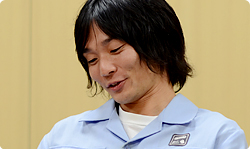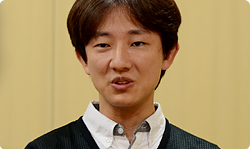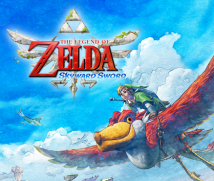2. The Logical Dungeon
In our first “Iwata Asks” discussion about this game, I heard that the ancient civilisation led to some characters becoming robots.
Yes. That is another big characteristic of this stage. The characters and enemies in the desert are robots that run on electricity.
We wondered if we could call it electricity in the world of The Legend of Zelda. (laughs)
Yes, I can understand that. (laughs)
We thought about terminology like that and tried to avoid a robot design that would look incredibly mechanical.
Fujino-san, when you heard that, because of this ancient civilisation, there would be robots in the world of The Legend of Zelda, what did you think?
I thought, “Is that really alright?”
You thought, “Can we really put something like that in The Legend of Zelda?”
Yes. (laughs)
At first, everyone hesitated to put in anything mechanical.
That’s true.
But looking at the actual animation, they don’t seem out of place for the gameworld. They fit in somehow.
Yes. That shows the designers’ skill. We would simply convey functional points to them - like, “We want a robot that can do this.” - and they would come up with something that fit the world.
I do think you can chalk that up to skill in design, but how did they make them fit in? As someone with a background in design, what do you think, Kitagawa-san?
The designers in charge tried to give them a softer appearance. They referred to ancient clay figurines and pottery from the Jomon period in Japan and wondered what they would be like as robots. (Editor’s note: the Jomon period refers to a prehistoric period in Japanese history dating roughly from 14.000 BC to 300 BC, according to one of various theories currently existing in Japan. The Japanese term Jomon translates as “cord-patterned”, referring to a pottery style in which markings were made using sticks with cords wrapped around them, which is representative of this period in history.)
I see. It’s an ancient civilisation, so they used those as motifs. Usually, you would design robots to be metallic and hard, but they were able to make them look softer by basing them on ancient Japanese earthen figures. And they were able to make them fit naturally into the world of the game.
I think so.
What other aspects of the game came about because of the ancient civilisation?
The map, for example. In terms of the first area, the one that I worked on, when you’re walking around in the present, there are puzzles you can’t see, so you can’t solve them. Then you get an ancient map, so you understand how that area was laid out long ago. Then you overlap the present circumstances onto that.

Since it’s a desert, there are places you can’t advance into because of the quicksand, but when you look at the ancient map, you can see there are ruins hidden underneath.
So that ancient map serves as a hint for making progress.
Oh. That’s like looking at an old map of Heian-kyo, Japan’s old capital, as you walk around Kyoto today. Now I’d like to ask about the second area. Earlier, Fujino-san mentioned using a boat to travel through the desert when it becomes a sea, which is a little unclear. What in the world do you mean?
The first thing I thought was, “What would be interesting to contrast with a desert when it transforms?”
The sea.
Yes. And if there’s a sea, there’s got to be a boat.
You ask for a lot. (laughs)
Yes. (laughs) In the usual way, I said to Fujino-san, “Sea and ship. Let’s put in a sand ship for crossing the desert!”
How did you take such a wild request, Fujino-san? (laughs)
I thought it sounded interesting. He wanted to have a boat, so I gathered a bunch of resources about ships.
His desk was really something. It was piled high with books about water vessels, cross-sections, blueprints, and such.
What did you do with those?
I flipped through them from cover to cover and picked out ideas. I wrote down notes on what stood out to me, and I thought round and round in my head, “I could use that...” and “I can’t use that.”

Oh, okay. You broke down the various elements, turned them over in your head, and then put the separate pieces together, saying, “It would be great if I combined this with that,” and “These would go together nicely.”
Exactly. Then I gradually got a vague image of it. But two or three pieces just wouldn’t come together.
You can only do so much on your own.
Yes. Once I reached that point, I presented it to everyone. Then the landform designers and programmers added ideas.
The idea you had cultivated in your head hadn’t reached completion, but you had raised it to a certain point, so various people could give you suggestions, like, “You can finish it if you do this.”
That’s right. They were a big help.
How many times, including this game, have you been a planner?
I was a programmer through The Legend of Zelda: Phantom Hourglass.5 I was a planner for the first time with The Legend of Zelda: Spirit Tracks6, so this was my second time. 5The Legend of Zelda: Phantom Hourglass: A stylus-controlled action-adventure game released in June 2007 in Japan as the first title in the Legend of Zelda series for the Nintendo DS system. 6The Legend of Zelda: Spirit Tracks: A stylus-controlled action-adventure game released for the Nintendo DS system in December 2009.
I didn’t participate in The Legend of Zelda: Spirit Tracks, so I could play from the point of view of a regular player. Playing just a little, I could tell which dungeons Fujino-san had made. He has a distinct touch! (laughs)
Oh, how so?
A good thing is that he makes these incredibly straightforward Legend of Zelda dungeons focusing on solving puzzles. But another thing is...they’re intensely logical.
Ah. Like you have to be logical like a programmer to solve them?
Yes, that’s it! They’re logical dungeons! (laughs) And we wanted to make a dungeon like that in the desert this time, so he was perfect.

I see. Once it was in your hands, Fujino-san, what kind of gameplay did you think of for the desert’s second area?
You know how this game has Dowsing, right?
It’s a way to look for Zelda and various items.
Listening to the other stage developers talk, I realised that up until arriving at the stage I was working on, there wasn’t much gameplay involving looking for something moving in real time.
What you were looking for was fixed in place or standing still.
That’s right. But the stage I was working on was in the middle part of the game, so I wanted to raise the difficulty a notch and make gameplay that involved looking for something on the move. Then I thought of a big ship roving the seas and the player having to search for it .
It’s wandering around, so it is sort of like a game of tag.
Yes.
And your logical dungeons come into play here?
Exactly! (laughs) When they find the ship, I think everyone will have a good time! (laughs)
